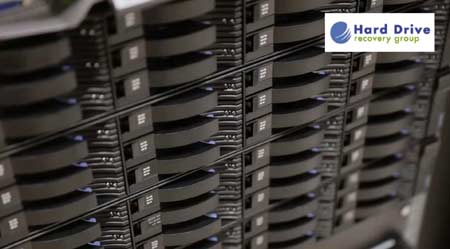When it comes to large RAID systems, database corruption is one of the most common causes of data loss that RAID recovery services like Hard Drive Recovery Group have to deal with. When a database becomes corrupt, it can become either completely unreadable or practically unusable, and businesses often experience significant downtime and financial losses as a result. On modern RAID systems, a variety of factors can contribute to database corruption; however, hardware failure is a common and potentially serious  contributor. It is important to understand the role that physical media issues can play in database corruption in order to increase your chances of a successful RAID data recovery.
contributor. It is important to understand the role that physical media issues can play in database corruption in order to increase your chances of a successful RAID data recovery.
Hardware, Corruption, and the Importance of Redundancy in the Workplace
Most businesses use RAID systems to store databases, email archives, and other large files or large sets of filesin order to benefit from the redundancy provided by RAID systems. Redundant systems that are RAID 5 and above store all data on at least two different local server drives, avoiding some of the most common causes of data loss and ensuring that all data is always available. However, data loss due to file corruption can still occur even in redundant systems as robust as RAID 10. In the event that a database management application shuts down unexpectedly on an otherwise healthy RAID server, database files can become corrupt, causing the RAID to write incorrect or incomplete data, even on a seemingly healthy disk set. This can result in databases that are jumbled, corrupted or unreadable.
If a single drive in a RAID fails, it is often still quite possible to recover a working set of data, depending on the RAID level and configuration. Unfortunately, even a single hard drive failure increases the likelihood of file corruption in a RAID system, as bad sectors on the remaining drive can prevent normal access to the data stored on the system. It is also possible to experience data synchronization issues, particularly during the RAID rebuild process. The good news is that many relational database management systems have been specifically designed to reduce the likelihood of corruption occurring in the database. However, all relational database management systems (RDBMS) are designed for functional systems, and physical media issues can certainly put a strain on software’s capabilities.
Preventing Data Loss as a Result of Database Corruption
To avoid database corruption, you should remember to find and use a relational database management system that is appropriate for your company’s needs. Never use an RDBMS that was designed for a small number of users if you have a large number of users who need to access your system on a regular basis, such as a large number of engineers. Additionally, remember to use RDBMS applications that are up to date and to not put off important updates.
Whenever you have to rebuild your RAID array due to a RAID hard drive failure, make sure to back up any critical database files before you begin the process. As with anything RAID, maintenance should be performed on a regular basis, and hard drive replacement should never be delayed, even if it seems like the drive is running like a champ. If you have a limited number of hard drives due to the loss of one, your RAID will still function properly, but it will not be fully redundant, and you will have a higher chance of experiencing corruption-causing issues.
Perform regular analysis of your RAID and replace any hard disk drives that have a disproportionately high number of bad sectors. Waiting for your hard drives to fail on their own is not a good idea. Finally, make regular interval backups of your data as well as full backups of all of your data backups. Test your backups on a regular basis (maybe once every two weeks), and ensure that your company has the ability to restore from its archival backups if the need arises.
Database Corruption Can Almost Always Be Fixed, and Your Data Can Be Recovered
If you are experiencing data loss as a result of database file corruption or another related issue, you should immediately shut down the RAID server, whether it’s a RAID 5 or RAID 10. For professional data recovery services, seek the assistance of a data recovery company that has previous experience with your RDBMS. If you do not have a complete, working backup of your data, do not attempt to recover it yourself. Our team of experienced data recovery engineers can work with corrupted databases using proprietary software, and in many cases, they are able to recover the entire database for our clients.
Additionally, a Class 10 ISO 4 Cleanroom is used by Hard Drive Recovery Group to treat physical hard drive issues. Our engineers have extensive knowledge of database corruption and have worked with all major relational database management systems. Call us right away to get started or for more information on database corruption and RAID configurations.
